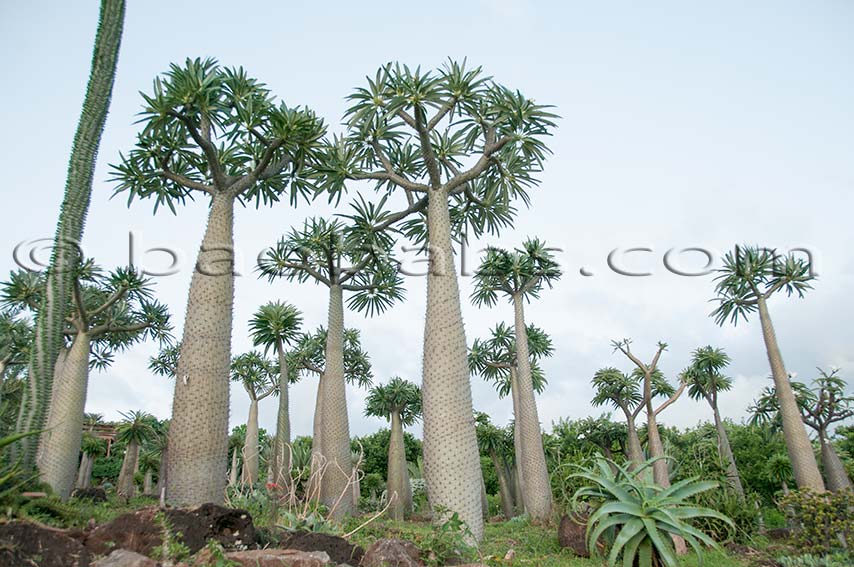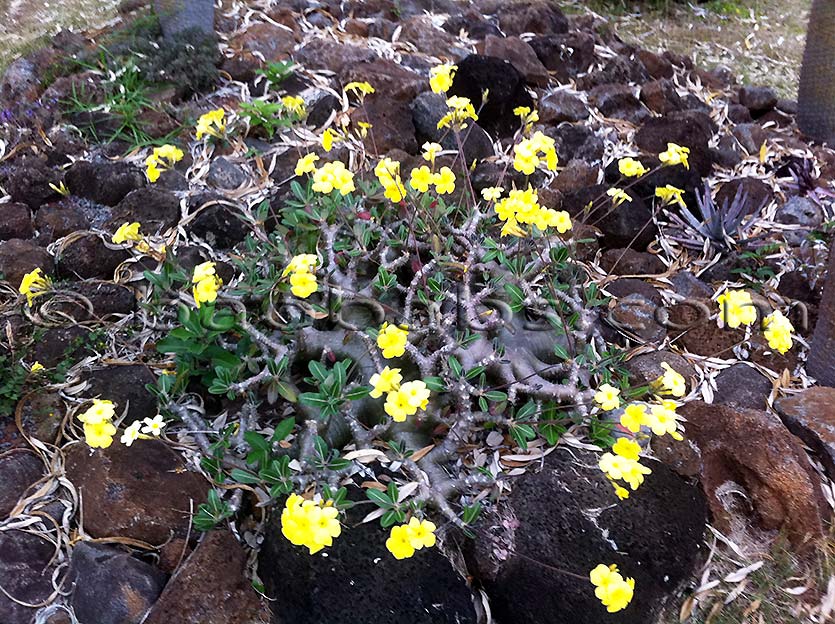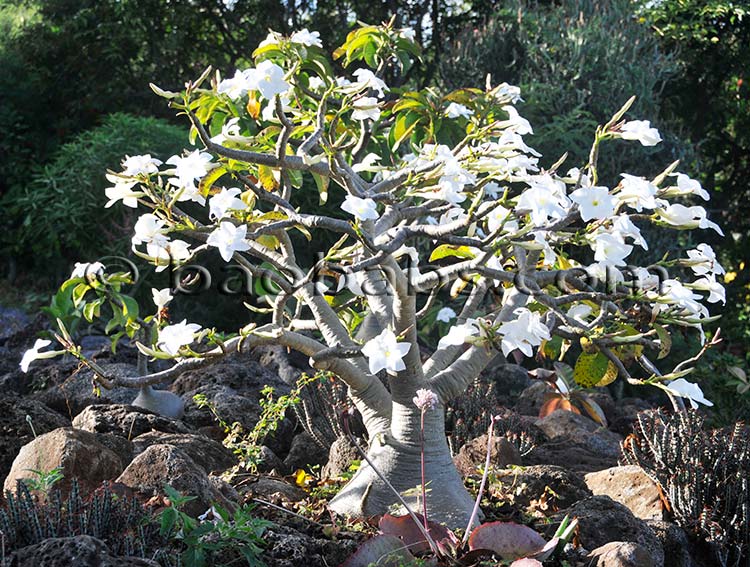
Pachypodiums geayi - Pachypodium lamerei - Le Jardin Naturel (Reunion)
GENERAL INFORMATIONS
Nowadays Pachypodiums are among the most popular plants with amateurs of succulents.
The Pachypodiums are mainly endemic to Madagascar and some of them to South Africa and Namibia.
The irresistible attraction of these plants lies in the very specific and diverse forms, from small prostate plants (Pachypodium brevicaule - Madagascar) to the tree-type like a Baobab with a fat trunk (Pachypodium rutenbergianum - Madagascar), and in their very beautiful flowers. They can also be very well cultivated as potted plants in temperate countries.
But even though the cultivation is not very complicated, it is important to have a basic knowledge about the care and the culture conditions of these "strange " plants.
It is very important to see in that these plants require regular monitoring and a basic knowledge of the various stages along their annual cycle. For example, it does not necessarily mean that the plant needs water just because the leaves are getting yellow and fall off. It can also be a natural reaction during this season.
You should simply be aware that the Pachypodiums are different from other plants with which you already have experience with.
Even if they are not really hard to maintain it is necessary to know the basic knowledge of their life cycle, their needs at different times of the year, their symptoms to various problems and possible remedies.
![]() WE SELL SEEDS AND PLANTS OF PACHYPODIUM
WE SELL SEEDS AND PLANTS OF PACHYPODIUM
SOME SPECIES OF PACHYPODIUM
You can put Pachypodiums in various 'big categorys', where the growing conditions are more or less the same:
- The 'prostrate' Pachypodiums,
:: Endemic to Madagascar: Pachypodium rosulatum (rosulatum var. rosulatum), Pachypodium gracilius (rosulatum var. gracilius), Pachypodium cactipes (rosulatum var. cactipes), Pachypodium bicolor, Pachypodium eburneum, Pachypodium inopinatum, Pachypodium horombense, Pachypodium densiflorum, Pachypodium brevicaule, etc.
:: Endemic to South Africa: Pachypodium bispinosum, Pachypodium succulentum.

Pachypodium rosulatum - Le Jardin Naturel (Reunion)
- The 'upstanding' Pachypodiums :
Endemic to Madagascar : Pachypodium firehense (= lamerei var. firehense), Pachypodium ambongense, Pachypodium decaryi, Pachypodium drakei, Pachypodium baronii (baronii var.baronii), Pachypodium windsorii (baronii var.windsorii).

Pachypodium decaryi - Le Jardin Naturel (Reunion)
- The 'columnar' Pachypodiums :
Endemic to Madagascar : Pachypodium lamerei ramosum, Pachypodium lamerei lamerei, Pachypodium geayi, Pachypodium mikea, Pachypodium rutenbergianum (rutenbergianum var. rutenbergianum), Pachypodium sofiense (rutenbergianum var. sofiense), Pachypodium meridionale (rutenbergianum var. meridionale).
- The Pachypodiums from summer-rainfall areas (rainy in summer, dryness in winter)
Endemic to South Africa: Pachypodium saundersii (= lealii var. saundersii), Pachypodium bispinosum, Pachypodium succulentum, etc.
- The Pachypodiums from winter-rainfall areas (rainy in winter, dryness in summer)
Endemic to South Africa and Namibia : Pachypodium lealii (= lealii var. lealii) , Pachypodium namaquanum.

Pachypodium lealii lealii - Namibia
![]() WE SELL SEEDS OR PLANTS OF PACHYPODIUM
WE SELL SEEDS OR PLANTS OF PACHYPODIUM
LIVING CONDITIONS OF PACHYPODIUMS
There are two different ways to look at things :
- The first is to inspect the living conditions of the plant in its natural environment (Madagascar or Africa) and try to imitate them as much as possible at home. Unfortunately, this is often quite difficult, if not impossible. For these who don't live under the tropics or in similar conditions as in Madagascar and Africa it will not be possible to reproduce similar conditions except for some lucky few (like us at Le Jardin Naturel). So we will considere the second approach.
- The second method (the method that is presented on this page) is to maintain the Pachypodiums under the best possible conditions for their flourishing with the aim to give them a possible 'natural' phenomenon. It is therefore necessary to know some basic parameters.
The annual cycle : hibernation - flowering and fruiting - growth
For the successful cultivation of Pachypodiums it is necessary to understand the different living conditions of these plants in their annual cycle. This helps to decide when to water, when repotting is good, and what care is necessary during the different phases as the phase of growth, flowering, fruiting or even the rest time.
The success of their crops will depend on your understanding of the various stages in the annual cycle : When and how much should you pour that substrate, when repotting, when the dormancy, how much and what light the plant needs when, when you should prune the branches , etc. .. There are no absolute rules about the culture de Pachypodiums and you should rely on your intuition and pay attention to your experience during the years.
Depending on where you live on the planet the different cycles are not at the same time of the year.
These phases can also vary depending on the latitude, depending on the distance to the tropics.
In the northern hemisphere the growth cycle begins around May with flowering and fruiting (reproduction). In the southern hemisphere this phase begins approximately in November.
But it also depends on the kind, there are varieties that can repeatedly blooming in the year (Pachypodium rosulatum rosulatum, Pachypodium decaryi for example), depending on how they are grown because it depends mainly on the 'dry season irrigation' from that can be caused artificial or natural.
- The rest period in which the Pachypodiums lose all their leaves, usually begins in September to October (May in the Southern hemisphere) and may take 3 months or more. This is the most critical period.
- The flowering period can last from 1 to 4 months from March to July (September to January in the southern hemisphere). Between flower and fruit (seed) , it can take (depending on the type of Pachypodium) 6 weeks (type rosulatum) to 6 months (type ambongense).
- The growth period of the Pachypodiums can begin during the flowering period and lasts until the beginning of the rest period.
You should not worry about the differences between the seasons in the different hemispheres, as the Pachypodiums can adapt to the cycles well. An exception is the Pachypodium namaquanum and Pachypodium lealii lealii from Namibia, they have random growth periods and the periods are difficult to detect because they usually have more cycles per year.
The majority of the care for the Pachypodiums is during the growth phase, but there are also some kinds of type 'with small leaves' , in which the most complicated and risky period is the period of rest. There are the following types: Pachypodium rosulatum, Pachypodium gracilius, Pachypodium cactipes, Pachypodium bicolor, Pachypodium eburneum, Pachypodium inopinatum, Pachypodium horombense, Pachypodium densiflorum, Pachypodium Drakei, Pachypodium brevicaule, etc.
About the species that I just have mentioned, the risk of stunting during the rest period is important. One should not completely stop watering, even if you far should water as much as in the summer. You should also note the light, temperature and humidity. A root death should be prevented in any case and it could be caused by excessive dryness and various insects and fungi that attack the roots and cause the death of the plant, if you do not respond in good time.
![]() WE SELL SEEDS OR PLANTS OF PACHYPODIUM
WE SELL SEEDS OR PLANTS OF PACHYPODIUM
SOME CHARACTERISTICS OF THE PACHYPODIUMS
The Pachypodiums are succulent plants such as the cactus, but the basic difference is that the Pachypodiums have visible leaves, in some species the leaves are even very large in relation to plant (For example Pachypodium rutenbergianum, Pachypodium lamerei).
This characteristic means that this plant use its leaves to acquire their necessary needs for water and carbon dioxide quickly. So they acquire their nutritional needs especially during the rainy season which may be suddenly and violently in the warm season. This is necessary for them as the growing season is quite short in their natural environment.
The Pachypodiums have large fibrous roots that absorb moisture very quickly as they need to take advantage of the sudden (but very rare) good rains in their natural habitat. In contrast, the majority of the other succulent plants has much finer roots.
The Pachypodiums have a thick and shiny bark that makes it possible for them to reflect the strong sunlight and to protect themselves from drying out during the long periods of drought.
Within the caudex, within the cortex, there is a fibrous soft part which is filled with liquid as a water reservoir.
At this stage we can say that if we want to create as robust and compact plants as possible like in their natural habitat, what makes undeniable their charm, then we must admit a long dormant period for the plants. During this time, you must still be aware of their health status and the plant requires a minimum of care.
CULTIVATION OF PACHYPODIUMS
The key to success: light - temperature - watering
The three parameters of light, temperature and watering are closely linked: you should not change one without the other two. It is therefore important to note that the balance of these three parameters determine the good or bad health of their plant.
The culture of pachypodiums it's not an exact science because you can change each of the 3 parameters to a certain degree, without compromising the health of the plant. But it might be necessary to realize that there are limits and you should act according to your 'feeling'.
You should keep in mind that the 3 parameters determine the general appearance and the proportions between the caudex and the trunk and the branches.
What light do Pachypodiums need
All kinds of Pachypodiums - except perhaps Pachypodium suculentum and Pachypodium bispinosum from South Africa - need much light because they originally grow under full sun in tropical countries.
Therefore, you must at least put the plant 3 hours per day in direct sunlight, in a southern location in the northern hemisphere and the opposite in the southern hemisphere.
Direct sunlight is not absolutely necessary, but the sunlight should not be shielded by a natural (or artificial) view protection. Basically, it would be better if the plants have 3 or 4 hours of not standing at a light-shielded place but in the sun. A window glass is not considered as a shield.
A Pachypodium with a lack of light will wither, its branches will be weak and appear "lean" and the leaves will be too big and soft. Over time the Pachypodium will be susceptible to disease and fungus and the plant will eventually die.
A good indication of a healthy plant with vigorous growth is the the distance between two branches (for example, two successive sheets). It should be short and the plant should have a compact appearance.
The Temperature
The temperature can be very high, as in the habitats in Madagascar and South Africa in the summer. However, if you have your pachypodiums in the greenhouse during the hot period, you should consider the ventilation good, as it may cause damage at the plant and otherwise the plant will 'go to sleep' as in the cool period. The growth sites could wither, run out and dry up when there is inadequate ventilation.
The minimum temperature is much more impotant for growing pachypodiums because it triggers the rest. For most types of pachypodiums the minimum temperature is about 13 ° C , but it depends very much on the moisture of the substrate. The drier the substrate, the lower temperatures are possible. Ideally you shouldn't fall below a minimum temperature of 15 ° C during the rest period.
There are two exceptions :
- The Pachypodium brevicaule that grows in Madagascar in the region Ibity (high plateau) where the temperature during winter can also easily fall sometime below 0 ° C (Caution : Dry season). It can be achieved also temperatures of up to -5 ° C.
- The Pachypodium densiflorum also grows in high elevations in Madagascar (but not as high as the previous one) , so it can also stand under low temperatures, but not below 0 ° C.
Watering
In the growth phase the pachypodiums require a lot of water. The fact is that the climatic environment drives them to store as much water as possible in a short time. As the rainy season can be very short, the plant must quickly invest their reserves. Some people say they are opportunists.
For beginners it is sometimes difficult to consider when and how much water you should give the Pachypodium. You should not treat it like a cactus in any case.
A helpful rule is to not be completely dry to the soil during periods of growth before it is poured again. To 'measure' to the need for irrigation, it is a good technique to weigh the pot (dry and wet) to get an idea of dryness. Thereafter, it may be easier to decide if you should water again or rather not. Be sure to leave the pot always in the same position. Turning the pots may confuse the pachypodiums and they can take several days or weeks to get used to the lighting conditions.
Be very careful with it, also to test the moisture in the pot, to use a tool or fingers to dig in the earth. You will most likely break roots and you risk damaging the root system and gradually killing the plant.
With a little practice with pachypodiums you can estimate at a glance whether you have to water the plant or not.
The dormancy or rest period of Pachypodiums
This is the most delicate moment to decide if you should water or not and how much.
It is the time that is most misunderstood by beginners. In fact, it is different from other succulents so that the plant is not likely to survive without irrigation until next spring.
Although the plants are very hard plants, you should consider that the plants need regularly water to replenish its moisture reserves in the rest period.
In La Reunion in our Le Jardin Naturel, in the western part of the island where the winter is dry and where the pachypodiums growing in the soil (or rather in the stony soil), it happens that Pachypodium rosulatum withers after a few weeks of drought. Over time, we have found out that only a few millimeters of rain suffice to bring them back in a few hours into its original shape and to stay like this for a few weeks! And this even though the earth is not nearly completely soaked!
In the regions in Madagascar (where the majority of the pachypodiums grow) it is in the so-called dry season often late at night and early in the morning very foggy, what will also donate enough moisture to the plant. In the intense sun during the day pachypodiums dry naturally very fast.
I come to the conclusion that it is necessary during the rest period that the plant can collect a little moisture, so that they can replenish their reserves, whether through the bark as in fog or directly from the earth.
The problem with the dead roots
What to do when the 'crumpled' pachypodiums as Pachypodium densiflorum or Pachypodium rosulatum show signs of stunted growth despite regular watering, even in the 'good' phase of growth? The symptoms are a going down of the caudex despite wet soil and often an occurrence of a type moss on the surface of the soil in the pot (in relation to the ongoing soil moisture).
First, you should replant the Pachypodium, remove all the substrate and clean the root system with water. Remove all dead or scruffy roots.
Then you can apply a hormone to promote root growth on the healthy roots, then let the plant a few days to dry in the open air, so that the wounded root tips can heal.
Then plant the Pachypodium almost exclusively in a mineral soil, gravel or pebbles or pumice for example, with a very little of high-quality soil, but only very little. Keep in mind that many pachypodiums live in their natural habitat in Madagascar in cracks and crevices and have very little organic matter available.
The medium for the Pachypodiums
Note: The columnar species of Pachypodium lamerei , Pachypodium geayi , Pachypodium rutenbergianum etc are very robust and easy to care for, they can adapt to any substrate and can deal with many different mounting errors.
For the other cultivars of the main point is the respect of drainage. A substrate for a Pachypodium should pass the water very well.
The substrate should retain the water not too long and not too little in the medium. It should also have a part of mineral material (stones), especially for the 'positioned' and 'crumpled ' varieties (see above).
Sand is not recommended because it restricts the freedom of the mixture and the roots of Pachypodium are not so strong that can penetrate through very "solid" zones.
The substrate should therefore be airy and loose. You should not hesitate to put also a bit of organic material (such as qualitative mother earth) on the surface, because as you can imagine in the natural environment by wind and rain sometimes humus comes to the surface. A bit of charcoal powder from time to time can not hurt either.
I am absolutely not a fan of fertilization, especially not the chemical, and as a beautiful natural soil mix is perfectly adequate, but well ... you'll see!
How big is the pot should be chosen?
In my opinion it is to grow the plant as soon as possible a big mistake. And to plant them in a large pot as well. You should keep in mind that the specificity of this type of plant, a plant with caudex, lies in their form. The shape is a consequence of the conditions of life, which is given to the plant by their environment. A fast-growing Pachypodium is scrawny and grows like an asparagus in the air, without spreading and creating reserves in the caudex.
In my opinion you should choose the volume of the pot about so that it is approximately the same volume of the plant has (estimated by eye). You should not repot the plant in a larger pot before the roots do not grow out of the holes of the pot.
Insects and diseases
Fortunately, the Pachypodiums are very rarely attacked by insects and also fungis are scarce. It is always better to solve the problems that may occur in a mechanical way (such as spraying water on the leaves, when beetles are on) or to try biological and organic products. Most of the problems come from the treatment and the cultivation, so it is important to first think before treating the plant with an aggressive product, because the consequences for the plant could be very bad.